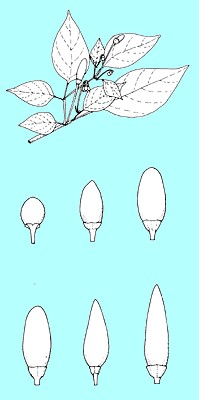
Synonymy
*Capsicum annuum L. var. glabriusculum (Dunal) Heiser & Pickersgill, Baileya 19: 156 (1975)
C. hispidum var. glabriusculum Dunal, in DC., Prodr. 13(1): 420 (1825).
T: In Mexico, near Bejar, Berlandier n. 1863; near Tampicode de Tamaulipas, Berlandier n. 95; n.v., both in Herb. Moricand which is housed in G.
C. frutescens var. queenslandicum Domin, Biblioth. Bot. 89: 572 (1928).
T: Near Harveys Creek, North Qld, Jan. 1910, Domin s.n.; PR, n.v., fide D.E. Symon, J. Adelaide Bot. Gard. 3: 137 (1981).
An image of the lectotype specimen for C. annuum can be seen on the Linnaean Plant Name Typification Project pages.
Description
Shrub to 2 m; distal branches often widely forked.
Leaves ovate, the lamina 12 cm long, 5 cm wide, frequently smaller; petiole 1–4 cm long.
Flowers solitary, rarely two, in each axil; pedicels 15–20 mm long. Calyx 2–3 mm long. Corolla c. 15 mm diam., white. Staminal filaments 1 mm long; anthers 1.5–2.5 mm long, bluish. Ovary obtusely conical, 2.5 mm long; style 4 mm long.
Berry erect, globose or ovoid to oblong-conical, to 25 mm long, 5–10 mm diam., bright orange-red; fruiting pedicel 20–35 mm long. Seeds 3–4 mm long, yellow.
Distribution and ecology
A native of South America but widely cultivated. Recorded from Darwin, N.T., north-eastern N.S.W. and much of eastern Qld. A single record from the Kununurra region in W.A.
Often found at edge of rainforest or in rainforest regrowth
Common name
Cayenne pepper
American bird pepper or Bird pepper
Chiltepin, chiltepe or chilipiquin (Spanish)
Notes
Differs from the cultivated pepper C. annuum L. var. annuum, in which the fruits are usually more than 10 mm diam.
C. annuum L. var. annuum is native to tropical America, but is widely cultivated in temperate and tropical regions. Var. glabriusculum is considered to be a reference to the wild forms native to the southern United States and Mexico south to Colombia. According to Guzman et al. (2005) C. annuum L. var. glabriusculum is thought to be the taxon of origin of all cultivated C. annuum types and C. annuum and C. frutescens are not biologically distinct even though recognised at the species level.
Ref: F.A. Guzma´n, H. Ayala, C. Azurdia, M.C. Duque & M.C. de Vicente (2005). AFLP Assessment of Genetic Diversity of Capsicum Genetic Resources in
Selected specimens
Qld: Near Yandoran, P. Sharpe & R. Dowling 2287 (BRI). Irvine Bank, Qld, D. Symon 4878 (AD). N.S.W.: Gunnedah, May 1974, R.J. Powell (NSW).
Images and information on web
Images of Capsicum annuum can be accessed through
- the Digital Flora of Texas site at www.csdl.tamu.edu/FLORA/imaxxsol.htm,
- through garden pages at www.mobot.org/gardeninghelp/plantfinder/Plant.asp?code=A101 and www.mobot.org/GARDENINGHELP/PLANTFINDER/Plant.asp?code=A685
- and through the Botanical and Experimental Garden of the Radboud University of Nijmegen site through www.bgard.science.ru.nl/ images/bgimages.htm
An excellent series of images of the leaves, fruits and flower can be seen on the Weeds of Mexico site.
Further information can be found through the Germplasm Resources Information network (GRIN) or through the USDA Plants Profile site.
A comprehensive fact sheet on C. annuum in